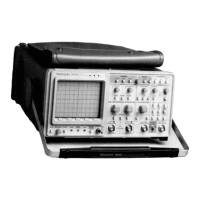2-3
Operation of the diagnostics features and troubleshoot-
ing of the 2430 are detailed in Section 6 of this manual
(Maintenance) under "Calibration and Diagnostics." Con-
sult your service department, your local Tektronix Service
Center, or nearest Tektronix representative if further
assistance is needed.
A fatal fault in the operating system will cause the
scope to abort. No displays are possible, and the user is
notified of an abort situation only by the flashing of the
Trigger LED indicators (if that is possible). Cycling the
power off then back on may clear the problem, but a
failure of this magnitude will usually require the scope to
be checked and repaired by a qualified service person.
Persistent or reoccurring failures of the power-on or self-
diagnostic test should be repaired at the first opportunity.
If the power-on self-test fails due to an actual com-
ponent failure, the scope may still be usable for the
immediate measurement purpose. For example, if the
problem area is in CH 2, CH 1 may still be used with full
confidence of making accurate measurements. Depending
on the nature of the failure, the "UNCALD" message may
or may not be displayed, but the failed test or tests will be
indicated by a "FAIL" message displayed with the associ-
ated EXTENDED DIAGNOSTICS test. Press the MENU
OFF/EXTENDED FUNCTIONS button to exit EXTENDED
DIAGNOSTICS to check out the scope for use.
The 2430 automatically performs power-up self tests
each time the instrument is turned on. These tests provide
the user with the highest possible confidence level that the
instrument is fully functional. If no faults are encountered,
the instrument will enter the Scope mode in the SAVE
Storage mode. Failure of a test in the range of 6000 to
9300 may not indicate a fatal scope fault. Several condi-
tions can occur that will cause a nonfatal failure of the
tests. In each of these cases, the abnormal condition is
brought to the user's attention by the scope entering the
"EXTENDED DIAGNOSTICS" mode. Recovery from some
abnormal conditions may be possible by simply pressing
the MENU OFF button to enter the Scope mode. Running
the "SELF CAL" procedure after the scope has warmed
up ("NOT WARMED UP" message is removed from the
main CALIDIAG menu in about ten minutes after power-
on) may also eliminate the cause of the nonfatal error.
Refer to "Calibration and Diagnostics," located in Section
6 of this manual, for information on the power-up tests
and the procedures to follow in the event of a failed test.
START-UP
Preparation for Use-2430 Service
All operating information pertaining to the use of the
menus, controls and connectors, operators familiarization,
and basic applications is found in the 2430 Operators
Manual. A User Reference Guide, supplied with the 2430,
provides quick reference to the menu-selected features of
the instrument. GPIB operating information is included in
the Operators Manual. Additional information on the GPIB
(General Purpose Interface Bus) may be found in the
Instrument Interface Guide, written specifically for system
programmers.
OPERATING INFORMATION
To prevent instrument damage from overheated com-
ponents, adequate internal airflow must be maintained.
Before turning on the power, first verify that air-intake
holes on the bottom and side of the cabinet and the fan
exhaust holes are free of any obstruction to airflow. The
scope has a thermal cutout that will activate if overheating
occurs. The scope shuts down immediately with no
attempt to save waveforms or front-panel conditions if a
cutout happens. Power will be disabled to the scope until
the thermal cutout cools down, at which time the power-on
sequence is redone. The resulting loss of the last front-
panel and waveform data will cause the power-on self test
to fail and is indicated to the user by a failed CKSUM-
NVRAM test (number 6000 in the main EXTENDED DIAG-
NOSTICS menu). The cause of the overheating must
be
corrected before attempting prolonged operation of the
scope. Pressing the MENU OFF/EXTENDED FUNCTIONS
button exits the EXTENDED DIAGNOSTICS mode to the
normal operating mode.
INSTRUMENT COOLING
Instruments are shipped with the required power cord
as ordered by the customer. Information on the available
power cords is presented in Table 2-1, and part numbers
are listed in "Options and Accessories" (Section 7). Con-
tact your Tektronix representative or local Tektronix Field
Office for additional power-cord information.
This instrument has a detachable three-wire power cord
with a three-contact plug for connection to both the power
source and protective ground. The power cord is secured
to the rear panel by a cord-set securing clamp. The pro-
tective ground contact on the plug connects (through the
power cord protective grounding conductor) to the accessi-
ble metal parts of the instrument. For electrical shock pro-
tection, insert this plug into a power-source outlet that has
a properly grounded protective-ground contact.
POWER CORD

